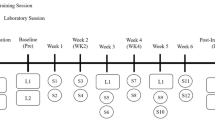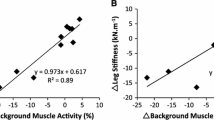Abstract
The ability to generate high muscular strength within short time periods is of functional importance not only as a basic quality in many sports disciplines but also for active stabilization of joints. The rate of force development (RFD) is generally used to describe this ability. The purpose of the present study was to examine the functional adaptations of a specific sensorimotor training on the explosive strength qualities of the leg extensor muscles during maximum isometric actions. Force and surface EMG were recorded in 17 subjects before and after a 4-week sensorimotor training period. Maximum static leg press strength did not change [608.2 (47.0) N to 627.8 (48.4) N before/after training], whereas maximum RFD (RFDmax) increased significantly from 4.95 (0.48) N/ms to 6.58 (0.76) N/ms (P<0.05). The gain in RFDmax was accompanied by an increased EMG of the M. vastus medialis. Enhancement of neuromuscular activation was only prominent in the early phases of muscular action. Neither force nor EMG parameters revealed significant improvements for time phases beyond 100 ms following the onset of isometric action. Enhanced extrafacilitatory drive from the afferent system is discussed as a potential mechanism for the improved neural activation. From a more functional point of view, this type of adaptation may be helpful in various sport performances. Moreover, with regard to injury related situations, enhanced neuromuscular activation is of distinct relevance in order to stiffen joint complexes actively within short time periods.






Similar content being viewed by others
References
Aagaard P, Simonsen EB, Andersen JL, Magnusson P, Dyhre-Poulsen P (2002a) Increased rate of force development and neural drive of human skeletal muscle following resistance training. J Appl Physiol 93:1318–1326
Aagaard P, Simonsen EB, Andersen JL, Magnusson P, Dyhre-Poulsen P (2002b) Neural adaptation to resistance training: changes in evoked V-wave and H-reflex responses. J Appl Physiol 92:2309–2318
Alt W, Lohrer H, Gollhofer A (1999) Functional properties of adhesive ankle taping: neuromuscular and mechanical effects before and after exercise. Foot Ankle Int 20:238–245
Bloem BR, Allum JH, Carpenter MG, Honegger F (2000) Is lower leg proprioception essential for triggering human automatic postural responses? Exp Brain Res 130:375–391
Buller AJ, Lewis DM (1965) The rate of tension development in isometric contractions of mammalian fast and slow skeletal muscle. J Physiol (Lond) 176:337–354
Burke RE, Rudomin P, Zajac FE III (1970) Catch property in single mammalian motor units. Science 168:122–124
Capaday C, Stein RB (1987) Difference in the amplitude of the human soleus H reflex during walking and running. J Physiol (Lond) 392:513–522
Caraffa A, Cerulli G, Projetti M, Aisa G, Rizzo A (1996) Prevention of anterior cruciate ligament injuries in soccer. A prospective controlled study of proprioceptive training. Knee Surg Sports Traumatol Arthrosc 4:19–21
Casabona A, Polizzi MC, Perciavalle V (1990) Differences in H-reflex between athletes trained for explosive contractions and non-trained subjects. Eur J Appl Physiol 61:26–32
Desmedt JE, Godaux E (1977) Ballistic contractions in man: characteristic recruitment pattern of single motor units of the tibialis anterior muscle. J Physiol (Lond) 264:673–693
Duchateau J, Hainaut K (2003) Mechanisms of muscle and motor unit adaptation to explosive power training. In: Komi PV (ed) Strength and power in sport. Blackwell, Oxford, pp 315–330
Edamura M, Yang JF, Stein RB (1991) Factors that determine the magnitude and time course of human H-reflexes in locomotion. J Neurosci 11:420–427
Garland SJ, Miles TS (1997) Control of motor units in human flexor digitorum profundus under different proprioceptive conditions. J Physiol (Lond) 502: 693–701
Gollhofer A (2003) Proprioceptive training: considerations for strength and power production. In: Komi PV (ed) Strength and power in sport. Blackwell, Oxford, pp 331–342
Gollhofer A, Komi PV, Fujitsuka N, Miyashita M (1987) Fatigue during stretch-shortening cycle exercises. II. Changes in neuromuscular activation patterns of human skeletal muscle. Int J Sports Med 8 Suppl 1:38–47
Gollhofer A, Strojnik V, Rapp W, Schweizer L (1992) Behaviour of triceps surae muscle-tendon complex in different jump conditions. Eur J Appl Physiol 64:283–291
Grabiner MD (1994) Maximum rate of force development is increased by antagonist conditioning contraction. J Appl Physiol 77:807–811
Grimby L, Hannerz J, Hedman B (1981) The fatigue and voluntary discharge properties of single motor units in man. J Physiol (Lond) 316:545–554
Gruber M (2001) Die neuromuskuläre Kontrolle des Kniegelenks vor und nach einem spezifischen sensomotorischen Training beim unverletzten Sportler. Dissertation, Stuttgart University
Gruber M, Bruhn S, Gollhofer A (2000) Training induced adaptions of functional stability of the knee joint. In: Proceedings of the 5th annual congress of the European College of Sport Science, Jyväskylä, Finland, 19–23 July 2000, p 296
Hakkinen K, Komi PV (1983) Electromyographic changes during strength training and detraining. Med Sci Sports Exerc 15:455–460
Hakkinen K, Komi PV (1986) Training-induced changes in neuromuscular performance under voluntary and reflex conditions. Eur J Appl Physiol 55:147–155
Hakkinen K, Komi PV, Alen M (1985) Effect of explosive type strength training on isometric force- and relaxation-time, electromyographic and muscle fibre characteristics of leg extensor muscles. Acta Physiol Scand 125:587–600
Hakkinen K, Kallinen M, Izquierdo M, Jokelainen K, Lassila H, Malkia E, Kraemer WJ, Newton RU, Alen M (1998) Changes in agonist-antagonist EMG, muscle CSA, and force during strength training in middle-aged and older people. J Appl Physiol 84:1341–1349
Hayashi R, Tako K, Tokuda T, Yanagisawa N (1992) Comparison of amplitude of human soleus H-reflex during sitting and standing. Neurosci Res 13:227–233
Henneman E, Somjem G, Carpenter DO (1965) Functional significance of cell size in spinal motoneurons. J Neurophysiol 28:560–580
Hultborn H, Meunier S, Pierrot-Deseilligny E, Shindo M (1987) Changes in presynaptic inhibition of Ia fibres at the onset of voluntary contraction in man. J Physiol (Lond) 389:757–772
Komi PV (1984) Physiological and biomechanical correlates of muscle function: effects of muscle structure and stretch-shortening cycle on force and speed. Exerc Sport Sci Rev 12:81–121
Konradsen L, Olesen S, Hansen HM (1998) Ankle sensorimotor control and eversion strength after acute ankle inversion injuries. Am J Sports Med 26:72–77
Kukulka CG, Clamann HP (1981) Comparison of the recruitment and discharge properties of motor units in human brachial biceps and adductor pollicis during isometric contractions. Brain Res 219:45–55
Llewellyn M, Yang JF, Prochazka A (1990) Human H-reflexes are smaller in difficult beam walking than in normal treadmill walking. Exp Brain Res 83:22–28
MacDougall JD, Elder GC, Sale DG, Moroz JR, Sutton JR (1980) Effects of strength training and immobilization on human muscle fibres. Eur J Appl Physiol 43:25–34
Macefield VG, Gandevia SC, Bigland-Ritchie B, Gorman RB, Burke D (1993) The firing rates of human motoneurones voluntarily activated in the absence of muscle afferent feedback. J Physiol (Lond) 471:429–443
Maffiuletti NA, Martin A, Babault N, Pensini M, Lucas B, Schieppati M (2001) Electrical and mechanical H(max)-to-M(max) ratio in power- and endurance-trained athletes. J Appl Physiol 90:3-9
Metzger JM, Moss RL (1990a) Calcium-sensitive cross-bridge transitions in mammalian fast and slow skeletal muscle fibers. Science 247:1088–1090
Metzger JM, Moss RL (1990b) pH modulation of the kinetics of a Ca2(+)-sensitive cross-bridge state transition in mammalian single skeletal muscle fibres. J Physiol (Lond) 428:751–764
Meunier S, Pierrot-Deseilligny E (1989) Gating of the afferent volley of the monosynaptic stretch reflex during movement in man. J Physiol (Lond) 419:753–763
Miller RG, Mirka A, Maxfield M (1981) Rate of tension development in isometric contractions of a human hand muscle. Exp Neurol 73:267–285
Milner-Brown HS, Stein RB, Lee RG (1975) Synchronization of human motor units: possible roles of exercise and supraspinal reflexes. Electroencephalogr Clin Neurophysiol 38:245–254
Moritani T (1993) Neuromuscular adaptations during the acquisition of muscle strength, power and motor tasks. J Biomech 26 [Suppl 1]:95–107
Narici MV, Hoppeler H, Kayser B, Landoni L, Claassen H, Gavardi C, Conti M, Cerretelli P (1996) Human quadriceps cross-sectional area, torque and neural activation during 6 months strength training. Acta Physiol Scand 157:175–186
Nelson AG (1996) Supramaximal activation increases motor unit velocity of unloaded shortening. J Appl Biomech 12:285–291
Nielsen J, Crone C, Hultborn H (1993) H-reflexes are smaller in dancers from The Royal Danish Ballet than in well-trained athletes. Eur J Appl Physiol 66:116–121
Rochcongar P, Dassonville J, Le Bars R (1979) Modification of the Hoffmann reflex in function of athletic training. Eur J Appl Physiol 40:165–170
Rozzi SL, Lephart SM, Sterner R, Kuligowski L (1999) Balance training for persons with functionally unstable ankles. J Orthop Sports Phys Ther 29:478–486
Sale DG, MacDougall JD, Upton AR, McComas AJ (1983) Effect of strength training upon motoneuron excitability in man. Med Sci Sports Exerc 15:57–62
Schmidtbleicher D, Haralambie G (1981) Changes in contractile properties of muscle after strength training in man. Eur J Appl Physiol 46:221–228
Semmler JG (2002) Motor unit synchronization and neuromuscular performance. Exerc Sport Sci Rev 30:8–14
Semmler JG, Nordstrom MA (1998) Motor unit discharge and force tremor in skill- and strength-trained individuals. Exp Brain Res 119:27–38
Sheth P, Yu B, Laskowski ER, An KN (1997) Ankle disk training influences reaction times of selected muscles in a simulated ankle sprain. Am J Sports Med 25:538–543
Simonsen EB, Dyhre-Poulsen P (1999) Amplitude of the human soleus H reflex during walking and running. J Physiol (Lond) 515:929–939
Sinkjaer T, Andersen JB, Ladouceur M, Christensen LO, Nielsen JB (2000) Major role for sensory feedback in soleus EMG activity in the stance phase of walking in man. J Physiol (Lond) 523:817–827
Staron RS, Malicky ES, Leonardi MJ, Falkel JE, Hagerman FC, Dudley GA (1990) Muscle hypertrophy and fast fiber type conversions in heavy resistance-trained women. Eur J Appl Physiol 60:71–79
Staron RS, Leonardi MJ, Karapondo DL, Malicky ES, Falkel JE, Hagerman FC, Hikida RS (1991) Strength and skeletal muscle adaptations in heavy-resistance-trained women after detraining and retraining. J Appl Physiol 70:631–640
Trimble MH, Koceja DM (1994) Modulation of the triceps surae H-reflex with training. Int J Neurosci 76:293–303
Trimble MH, Koceja DM (2001) Effect of a reduced base of support in standing and balance training on the soleus H-reflex. Int J Neurosci 106:1–20
Vallbo AB, Hagbarth KE, Torebjork HE, Wallin BG (1979) Somatosensory, proprioceptive, and sympathetic activity in human peripheral nerves. Physiol Rev 59:919–957
Van Cutsem M, Duchateau J, Hainaut K (1998) Changes in single motor unit behaviour contribute to the increase in contraction speed after dynamic training in humans. J Physiol (Lond) 513:295–305
Voigt M, Chelli F, Frigo C (1998) Changes in the excitability of soleus muscle short latency stretch reflexes during human hopping after 4 weeks of hopping training. Eur J Appl Physiol 78:522–532
Author information
Authors and Affiliations
Corresponding author
Rights and permissions
About this article
Cite this article
Gruber, M., Gollhofer, A. Impact of sensorimotor training on the rate of force development and neural activation. Eur J Appl Physiol 92, 98–105 (2004). https://doi.org/10.1007/s00421-004-1080-y
Accepted:
Published:
Issue Date:
DOI: https://doi.org/10.1007/s00421-004-1080-y




